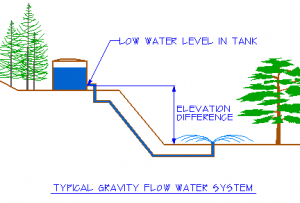When driving around your town you may have noticed large water towers which are very large elevated water storage tanks. Depending on the topography of the tower’s location they may be visible for miles around and are often emblazoned with the name of the town in which they are located. In hilly regions there is often no need for an elevated tower, the tank can be placed on the highest ground in the vicinity of the town and achieve the same elevation. While some may think of them as simply a picturesque part of the rural landscape, the towers have a practical purpose – they help supply the community with water.
 A Water Tower at Possum Park
A Water Tower at Possum Park
On a smaller scale, there are domestic water tanks that work on the same principle of elevation. They are often placed on a platform or a roof in order to elevate them. Elevated tanks may serve a household in a number of ways; most commonly as a catchment tank for rain water, or as a supply of emergency water in the event of a failure of the municipal water system. In some areas where there is no municipal water supply, an elevated water tank may serve as the household’s primary source of water.
Reasons for elevating water tanks
The primary reason is to create more water pressure. As with the tank on the back of the average household toilet, the tank’s position allows it to deliver water with more force. If a municipal water tank is elevated to more than a hundred feet above the ground, there is an increase of .43 psi per foot. A tank that has been elevated to an appropriate height can create water pressure similar to that created by a large pump. The ability to create water pressure with gravity alone means that the only fuel expenditure may be on the small pump used to fill the tank.

An example of a small slimline tank elevated on a metal stand
For the average household with a water storage tank, a water pump might not be necessary. If the tank is elevated a sufficient distance above the plumbing in the house, it may create sufficient pressure. For a water tank set up only to serve the garden and other outside water use, elevating the tank will probably provide sufficient (though not strong) water pressure. This eliminates the expense and installation of a pump, saving you time and money. An elevated tank is less easy for vermin to access, so elevating water tanks may also prevent some forms of water contamination, like from rats or mice.

The pros of elevated water tanks
* Eliminates the need for an electric pump to pump water out, which means less fossil fuels consumed and therefore less harm to the environment.
* There is less reliance on local water supply which may be expensive, unreliable or non-existent.
*Ensures a supply of water for gardening, washing cars or other needs even under water restrictions.
* Water from a municipal system is not always suitable for drinking; sometimes for health reasons, or because of an unpleasant taste. The options could be to buy expensive bottled water, or to collect rainwater.
The negatives of elevated water storage tanks
* Even though an elevated water tank can help to supply a home with rainwater, there is a risk of contamination from pollutants in the air if the tank is open at the top, therefore the water should be purified prior to drinking.



Leave A Comment